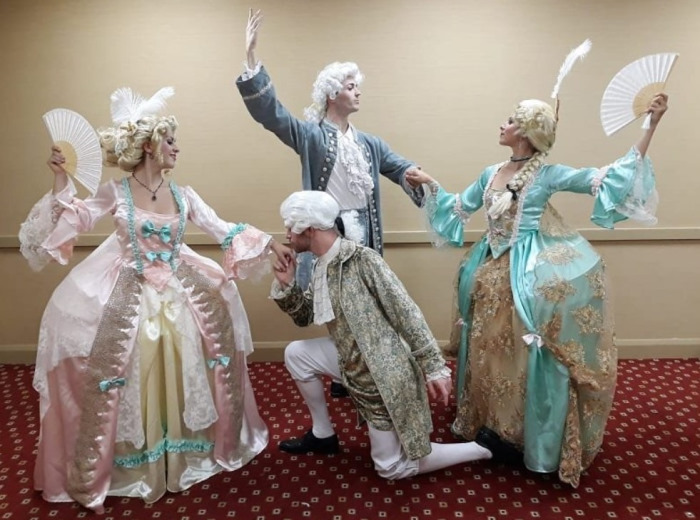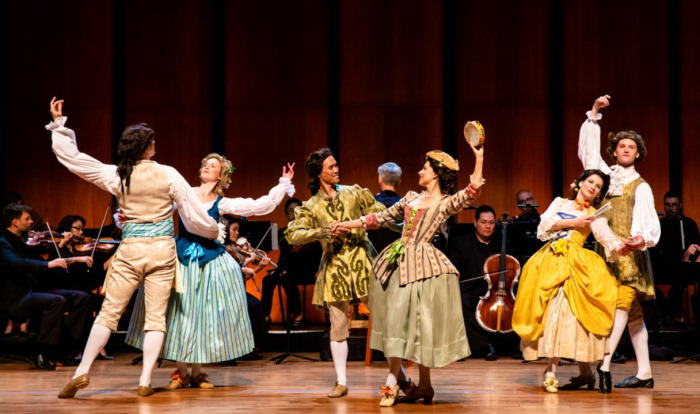The baroque dance marks a pivotal period in the history of dance. From simplistic dance movements and styles of earlier eras, baroque choreographers and dancers took the art to the next stage by experimenting with more complex, beautiful dances.
In fact, baroque dances are considered the stylistic ancestor of classical ballet!
Whether you’re looking for a curious read or you’re a historian researching how dance has transformed through the centuries … This article is for you! We’ll take a closer look at the origins, characteristics, types, music, and more of the baroque dance today.
Table of Contents
What Is The Baroque Dance?
The term “Baroque dance” isn’t used to refer to any particular dance style. Rather, it’s an umbrella term used to describe a variety of court dances that were popular in Europe during the Baroque period, which ran from the 17th century through the 18th.
Most of the popular dances that are considered “Baroque” have French origins. Such as the minuet, passepied, allemande, courante, gigue, sarabande, and the gavotte. Many of these dances were in 3/4 or 4/4 time and most had stylized steps that took intricate footwork to pull off well.
These complex routines were the reason why baroque dances are so interesting from a historical perspective. They lay the groundwork for future highly-complex dance styles to form, such as classical ballet!
Baroque Dance Origin: Where Did Baroque Dance Come From?
The name “Baroque dance” was borrowed from the Baroque period (1643–1715). The baroque dance developed within the dancing halls of the Versailles Palace, in the court of Louis XIV.
French culture had a lot of sway at the time, and any development was considered “en vogue.” As a result, Charles II and many other European countries soon introduced baroque dances to England. All over Europe, theaters and courts employed French dancing masters to help them learn these new stylish dances.
That’s the reason why baroque dance styles are all in French (menuet, sarabande, bourrée, gavotte, gigue, chaconne, courante, etc.) And not just the name of the dances, the names for the moves in baroque dances are also in French!
According to surviving historical records like the Beauchamp-Feuillet notation, there were well over 300 choreographies in the Baroque dance. However, the Beauchamp-Feuillet notation only shows you the steps, not how to do them.
Fortunately, there are many other sources, like Pierre Rameau’s Le Maître à danser (published in 1725), which teaches the reader detailed movements of each dance.
Thanks to these notes and notations, dance historians have been able to recreate most of the baroque dances today with pretty good accuracy. However, some controversies and debates still exist around the recreated dances.
But we aren’t going into detail about these controversies today!
Baroque Dance Characteristic
If you ask someone to describe “medieval dances,” they’ll most likely think about strict, rigid rules and tight choreographies. That’s how baroque dances are.
Since the baroque dance is meant to be a court dance (performed in royal courts and other high-class settings), it’s a highly structured kind of dance. The choreography is fixed and follows specific, predetermined patterns. Typically, the choreography has courtship-style movements that were super popular in the 1600s and 1700s.
Steps in baroque dances are also highly symmetrical and regular, which is vastly different from modern dances that encourage improvisation and relaxation.
Most of the dance forms in the baroque repertoire can be done solo. However, back in the day, dances were almost always performed in pairs.
You’ll love: All Traditional Chinese Dance Names With History
What’s the Difference Between Baroque and Classical Ballet?
Baroque is regarded as the precursor to classical ballet. But that doesn’t mean they’re the same thing. Ballet emphasizes going up on toes, while the Baroque dance was much more rooted to the ground with heels just off the floor.
The aesthetics of the two dances are different, too. Because of its structured character, baroque dances have often been described as “stiff.”
And stiff is the last thing classical ballet is!
It puts a heavier emphasis on being as smooth, graceful, and elegant as possible.
Baroque Dance Style
According to historical records, there were well over 300 dance styles and variations in the baroque repertoire. Out of them all, 7 styles were the most popular.
A baroque dance performance is done in “suite”, separated into movements. Each movement has its own song and a specific kind of dance.
So, if you go to a historical fair and watch a baroque dance performance, there’s a good chance that you’ll get to see all of the dance styles below!
Allemande
The Allemande (literally “German” in French) is a baroque dance of German origin. It’s characterized by loose body posture, accentuated hand gestures, and a shifting pattern of steps. This is a fairly upbeat, lively dance and follows a duple meter with a moderate tempo.
Allemande is usually the first movement in a baroque dance suite. However, sometimes, it’s going to be preceded by a short introduction (prelude) dance section. In that case, the Allemande will be the second movement.
Courante
Courante (means “Running” in Italian). It usually comes after the Allemande in a baroque dance suite as the second movement (third if there’s a prelude).
The dance is exactly like its name suggests, being characterized by a series of running and leaping steps.
There are two kinds of courante, French and Italian. In the French version, the Courante is described as “grave and majestic” and follows a 3/2 time. Out of all French court dances, the Courante is the slowest.
The Italian version, on the other hand, is much faster and livelier.
Sarabande
Sarabande (from the Spanish “Zarabanda”) is a Spanish court dance featuring slow walking steps with intricate arm gesture embellishments.
This baroque dance history is quite interesting. Originally, the dance was performed by a Spanish girl who danced and sang it in a very grave way. So solemn, King Philippe II of Spain outright banned the dance due to its “demonic” sound.
It further didn’t help its case that women mostly performed the Sarabande, the music originally had a lot of flirtatious lyrics, and the dance movements were quite sensual.
Because of this, a priest had written that it’s: “a dance and song so loose in its words and so ugly in its motions that it is enough to excite bad emotions in even very decent people.”
The dance later found its popularity again in the court of Louis XIV. The French variation of the Sarabande was slower compared to the Spanish. Records wrote that because of Louis XIV’s weight and size, they had to slow down the tempo to let him dance!
Typically, a Sarabande performance is in ¾ or 3/2 meter. It has a binary form, with a second section that’s longer than the first.
Gavotte
The Gavotte is a French dance. The name is an homage to the Gavot people, who resided in the Pays de Gap region in the southeast of France.
This festive dance typically has four beats in each bar with a two-step pattern transitioning between two sets of steps. The Gavotte is traditionally danced by partners or groups of couples who move in circles or lines. It includes prominent side-step steps and turns.
As the baroque dance music progresses, the steps become more intricate as dancers combine basic movement with light hops and graceful leaps.
The dance is very romantic and quite popular with couples back in the day. Early on in the baroque period, the dance can end with kissing. But later, this custom changed to a simple and more modest exchange of flowers.
Menuet
The Menuet is considered a rite of passage for young courtiers at the time. Out of all the baroque dances, this one’s quite possibly the most popular.
The name “Menuet” probably came from the full name of the dance itself, which was pas menus (“little leaps”). And the name, in turn, also describes the dance. It involves gliding figures led by “little leaps” on the downbeat.
During the period when it was most popular, the Menuet was described as “controlled, ceremonious, and graceful.”
Passepied
The Passepied (French for “passing feet”) is a light French court dance in triple meter with the feet moving in and out of each other (hence the name). This style originated in Brittany but quickly spread across France during the reign of Louis XIV.
In English, it is sometimes spelled “paspy” or “paspie,” resembling its French pronunciation.
You’ll find it in many operas and plays written in the 18th century during pastoral scenes. The passepied is so closely connected to farmlands and peasants that dancers back in the day wore costumes of shepherds and shepherdesses when they danced!
Bourrée
The bourrée is a French dance that’s quite similar to the gavotte, but it has a slightly more complex rhythm. It’s characterized by a sequence of rapid footsteps known as pas de bourrée.
Baroque Dance Suite
The order of a typical dance suite was already somewhat established by the time the most well-known baroque suites were composed by legendary composers such as J.S. Bach, Domenico Scarlatti, Antonio Vivaldi, and G.F. Handel.
Generally, it began with an Allemande, followed by a Courante, then a Sarabande, and finally a Gigue.
Often, there are additional dances interspersed between the Sarabande and Gigue known as the “galanterie” (French for “chivalry”). These short, extra movements are known for their light-hearted style.
Some baroque suites can also have a short introductory movement known as a prelude.
Baroque Dance Costumes

Baroque dance performances are still done today at historical fairs and special events. Performers generally try to draw inspiration from the fashion and clothing of the Baroque era (17th century).
Typically, for ladies, this means wearing a long dress or skirt and either a bodice top or corset.
Whereas for men, it can involve wearing trousers, a hose, and a waistcoat. A complete men’s costume could also include a jabot, or lace collar, as well as a sword.
Accessories such as masks, fans, or wigs can also be worn to give the ensembles more flair!
Baroque Dance Music
Closing Words
From its roots in the courts of European royals to modern performances at fairs and exhibitions, Baroque dancing has stood the test of time. But with all its intricate steps, ornate costumes, beautiful music, and fascinating history, it is no wonder why Baroque dance remains popular today.
We hope this in-depth guide has been insightful. If you have any other questions or knowledge that you’d like to share, we’d love to hear back from you in the comment section down below!
